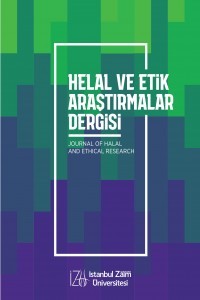HELAL İÇECEK AROMALARI: TURUNÇGİL ÖRNEĞİ
Günümüzde içecek emülsiyon ve aromalarının hazırlanmasında yaygın olarak kullanılan çözgen etil alkol olup, bu maddeye alternatif helal bileşenlerin belirlenmesi büyük önem taşımaktadır. İçecekler arasında da turunçgil aromaları ile hazırlananlar yaygın olarak tüketilmektedir. Bu çalışmada, portakal, mandalina ve limon aromalı içeceklerin ve bunlara ait emülsiyonların hazırlanmasında kabuk yağlarının taşıyıcısı olarak kullanılan bazı helal çözgenlerin, son ürün kalite parametreleri üzerindeki etkileri incelenmiştir. Bu amaçla propilen glikol, benzil alkol ve triasetinden oluşan bir helal çözgen kompozisyonu kullanılmıştır. Örneklerin bazı fiziksel ve mikrobiyolojik stabiliteleri ile duyusal özellikleri, 15 gün süre ile 40°C sıcaklık ve 100 000,0 lux ışık altında bekletildikten sonra incelemeye alınmıştır. Sonuç olarak, örneklerde toplam mezofilik aerobik bakteri ile maya-küf gelişimi gerçekleşmemiştir ve ayrıca çeşitli fiziksel stabilite problemleri (halka oluşumu, faz ayrımı ve çökme gibi) ile karşılaşılmamıştır. Örneklerin, renk özelliklerinin (L*, a* ve b*) ürünlerin karakteristik özellikleri ile uyumlu olduğu belirlenmiştir. Eğitimli panelistler ile gerçekleştirilen duyusal analizler sonucunda, örneklerin oldukça yüksek düzeyde bir beğeniye sahip oldukları ve aroma algı şiddetleri üzerine kullanılan helal çözgenlerin olumsuz hiçbir etkiye neden olmadıkları gözlenmiştir. Elde edilen sonuçlar dikkate alındığında, çalışma kapsamında kullanılan helal çözgenlerin etanole alternatif olarak turunçgil aromalı içeceklerde aroma taşıyıcısı olarak kullanılabilecekleri belirlenmiştir.
HALAL SOFT BEVERAGE FLAVORS: CITRUS EXAMPLE
It is important to determine halal solvents as alternative for ethyl alcohol, which is widely used in the preparation of beverage emulsions, flavors and aromas. Citrus flavors are widelyc consumed among soft beverages. In this study, the effects of some halal solvents used as carriers of citrus peel oils in the preparation of orange, mandarin and lemon flavored beverages and their emulsions, were investigated on the final product quality parameters. For this aim, a halal solvent composition, consisting of propylene glycol, benzyl alcohol and triacetin, was used. Some physical and microbiological stability and sensory properties of the samples were examined after storage for 15 days at 40°C and 100 000.00 lux. As microbiological stability parameters, total mesophilic aerobic bacteria and yeast and mold growth did not occur in the samples. Also, some physical stability problems such as ring formation, phase separation and precipitation were not observed. Colour parameters (L*, a* and b* values) were consistent with the characteristics of the products. According to result of sensory analysis conducted with trained panelists, it was observed that the samples had a high level of acceptability and likings, and that the halal solvent sused on the flavor perception intensities had no negative effect. Consequently, it was determined that halal solvents used in the study could be used as aromatic peel oils carrier in citrus flavored beverages.
___
- Anon., 2019. Gazlı içecekler, cola ve enerji içecekleri, niçin neden helal ve tayyib sertifikalandırma yapılamıyor? http://www.gimdes.org/gazli-icecekler-colalar-enerji-icecekleri- icin-helal-tayyib-sertifikalandirma-yapilamiyor.html Erişim; 20 Mayıs 2019.
- Alvarez, R., Carvalho, C.P., Sierra, J., Lara, O., Cardona, D., Londono-Londono, J., (2012). Citrus Juice Extraction Systems: Effect on Chemical Composition and Antioxidant Activity of Clementine Juice. Journal of Agricultural and Food Chemistry 60: 774-781, doi: 10.1021/jf203353h
- Cappelletti, M., Ferrentino, G., Endrizzi, I., Aprea, E., Batta, E., Corollano, M.L., Charles, M., Gasperi, F., Spilibergo, S., (2015). High Pressure Carbon Dioxide pasteurization of coconut water: A sport drink with high nutritional and sensory quality. Journal of Food Engineering 145: 73-81, doi: 10.1016/j.jfoodeng.2014.08.012
- Cheong, W.K., Mirohessini, H., Hamid, N.S.A., Osman, A., Basri, M., Tan, C.P., (2014). Effects of Propylene Glycol Alginate and Sucrose Esters on the Physicochemical Properties of Modified Starch-Stabilized Beverage Emulsions. Molecules 19: 8691-8706, doi: 10.3390/molecules19068691
- Choi, S.J., Decker, E. A., Henson, L., Popplewell, L. M., McClements, D.J., (2009). Stability of citral in oil-in-water emulsions prepared with medium-chain triacylglycerols and triacetin. Journal of Agricultural and Food Chemistry 57 (23): 11349-11353, doi: 10.1021/jf902761h
- Given, P.S., (2009). Encapsulation of flavors in emulsions for beverages. Current Opinion in Colloid & Interface Science 14 (1): 43-47, doi: 10.1016/j.cocis.2008.01.007
- Guichard, E., (2002). Interactions between flavor compounds and food ingredients and their influence on flavor perception. Food Reviews International 18: 49–70, doi: 10.1081/FRI-120003417
- Hutchings, J.B., (1999). Food color and appearance (pp. 19–21) (2nd ed.). Gaithersburg, MD: An Aspen Publishers.
- McClements, D.J., (2005). Food Emulsions: Principles, practices, and techniques (2nd ed.). Boca Raton, Fl: CRC Press.
- McClements, D.J., (2011). Edible nanoemulsions: fabrication, properties, and functional performance. Soft Matter 7 (6): 2297-2316, doi: 10.1039/C0SM00549E
- Mei, L.Y., Choi, S.J., Alamed, J., Henson, L., Popplewell, M., McClements, D.J., Decker, E.A., (2010). Citral stability in oil-in-water emulsions with solid or liquid Octadecane. Journal of Agricultural and Food Chemistry 58 (1): 533-536, doi: 10.1021/jf902665b
- Mirhosseini, H., Tan, C.P., Hamid, N.S.A., Yusof, S., (2008). Effect of Arabic gum, xanthan gum and orange oil on flavor release from diluted orange beverage emulsion. Food Chemistry 107: 1161-1172, doi: 10.1016/j.foodchem.2007.09.043
- Piorkowski, D.T., McClements, D.V., (2014). Beverage Emulsions: Recent developments in formulation, production, and applications. Food Hydrocolloids 42: 5-41, doi: 10.1016/j.foodhyd.2013.07.009
- Rao, J.J., McClements, D.J., (2012). Food-grade microemulsions and nanoemulsions: role of oil phase composition on formation and stability. Food Hydrocolloids 29 (2): 326-334, doi: 10.1016/j.foodhyd.2012.04.008
- Samaram, J., Mirhosseini, H., Tan, C.P., Ghazali, H.M., (2014). Ultrasound-assisted extraction and solvent extraction of papaya seed oil: Crystallization of thermal behavior, saturation degree, color, and oxidative stability. Industrial Crops and Products 52: 702-708, doi: 10.1016/j.indcrop.2013.11.047
- Tan, C. T. (1997). In S. Friberg & K. Larsson (Eds.), Beverage emulsions in food emulsions (3rd ed., pp. 491–524). New York, NY: Marcel Dekker Inc.
- Yayın Aralığı: Yılda 2 Sayı
- Başlangıç: 2019
- Yayıncı: İstanbul Sabahattin Zaim Üniversitesi
Sayıdaki Diğer Makaleler
HELAL İÇECEK AROMALARI: TURUNÇGİL ÖRNEĞİ
Nevzat KONAR, Seçil ŞENOCAK, Naike Neslihan ÜNLÜTÜRK, Hasan YETİM
SPORDA YAŞANAN ÖRNEK ETİK DAVRANIŞLARIN TOPLUMSAL KARAKTERİN OLUŞMASINA ETKİLERİ
Ayse Büşra MADENCİ, Selman TÜRKER, Zeki BAYRAMOĞLU, Vildan EYİZ
HELALLİK AÇISINDAN ALKOLLÜ İÇKİLER, İÇECEKLER VE GIDA MADDELERİNDE ALKOL
Hasan Hüseyin KARA, Yasemin BOR
HELAL GIDA ARAŞTIRMALARINDA GÜNÜMÜZ FIKIH PROBLEMİ OLARAK İSTİHÂLE VE İSTİHLÂK
